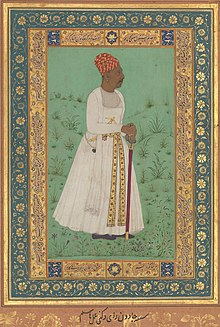Lakhuji Jadhav Rao (1560 – 25 July 1629), also known as Lakhuji Jadhav was a Maratha statesman and Mansabdar who initially served the Ahmadnagar Sultanate and later joined the Mughals. He was a prominent figure in the politics of Deccan. Lakhuji was a well-known member of Jadhav Rao clan descendants of the Yadavas of Devagiri. He was also a Jagirdar of Sindkhed Raja.[2][3] He was father of Jijabai, and grandfather of Shivaji, who was founder of the Maratha Empire.[4][5]
| Lakhuji Jadhav Rao | |||||
|---|---|---|---|---|---|
| Jadurai Dakkhani Maharao of Khandesh Maharajah of Sindhakhed Kanatiya Patshahi Wajir Mir-a-Samad Mansabdar Raje | |||||
 A contemporary portrait of Lakhuji Jadhav Rao. Jadurai Dakkhani is written in Persian language below the portrait. | |||||
| Mansabdar of the Mughal Empire | |||||
| Reign | 1621 – 25 July 1630[1] | ||||
| Predecessor | Position established | ||||
| Successor | Position abolished | ||||
| Mansabdar of the Ahmadnagar Sultanate | |||||
| Reign | 1585 – 1621 | ||||
| Predecessor | Position established | ||||
| Successor | Position abolished | ||||
| Jagirdar of Sindkhed Raja | |||||
| Reign | 1582 – 25 July 1629 | ||||
| Predecessor | Vithoji Jadhav Rao | ||||
| Successor | Raghoji | ||||
| Born | 1560 | ||||
| Died | 25 July 1629 (aged 69) Devgiri Fort, Ahmadnagar Sultanate (assassination) | ||||
| Spouse | Mhalasabai | ||||
| Issue | Dattaji Achloji Raghoji Bahadurji Jijabai | ||||
| |||||
| House | Jadhav Rao | ||||
| Dynasty | Yadava dynasty | ||||
| Father | Vithoji | ||||
| Mother | Thakrai | ||||
| Religion | Hinduism | ||||
Early life
editJagirdar of Sindkhed Raja
editThe Jadhav Rao family had hereditary possession of the Jagir of Sindkhed Raja. During the period of Lakhuji Jadhav Rao, Nizam Shah added some more territories to this Jagir.
Mansabdar of Ahmadnagar Sultanate
editLakhuji Jadhav was a prominent Maratha chief who played a pivotal role in the early development of guerrilla warfare tactics.[6][4] He rose to prominence as one of the most significant sardars in the Nizam Shahi Sultanate. Notably, he achieved renown as the victorious commander in the famous siege of the Devgiri Fort.[7] Following his triumph in the Khandesh War and the subsequent control of the Khandesh region, Lakhuji Jadhav assumed the title of Maharao of Khandesh, with crucial support from Shinde's of West Khandesh hailing from Dhanur and Songir. In 1782, He was appointed as Mansabdar with a mansab of 10,000 men by Ahmadnagar Sultanate.
Mansabdar of Mughal Empire
editTowards the end of the 16th century, the influence and power of the Maratha chieftains experienced a significant growth. The Mughals, who had long been intent on subduing and asserting control over the Deccan Muslim kingdoms, recognized the Maratha chiefs as a formidable military asset in the region and sought to enlist their support. In 1621, in their bid to establish control over the Deccan, Mughal emperor Jahangir conferred upon Lakhuji an impressive mansab of 24,000 men and granted him Jagir in the Deccan region.[8]
Death
editLakhuji Jadhav was assassinated at Devgiri Fort, along with his sons and a grandson, by the orders of the Burhan Nizam Shah III in 1629. [9] Lakhuji's descendants built his Samadhi (mausoleum) at Sindkhed Raja in his memory.[10][11][12] This Samadhi is a fine example of Maratha architecture.
References
edit- ^ The state at war in South Asia. University of Nebraska Press. 2005. p. 40.
- ^ Maharashtra (India) (1976). Maharashtra State Gazetteers: Buldhana. Directorate of Government Print., Stationery and Publications, Maharashtra State. p. 796.
- ^ Diwakar, P. G.; Sharma, B. D. (2000). Flora of Buldhana District, Maharashtra State. Botanical Survey of India. p. 2.
- ^ a b Census of India, 1991: Tables on houses and household amenities. Controller of Publications. 1997. p. 53.
- ^ Maharashtra (India) (1972). Maharashtra State Gazetteers: Botany. pt. 1. Medicinal plans. pt. 2. Timbers. pt. 3. Miscellaneous plants. pt. 4. Directorate of Government Print., Stationery and Publications. p. 492.
- ^ Donald W. Attwood (16 September 2019). Raising Cane The Political Economy Of Sugar In Western India. Taylor & Francis. p. 104.
- ^ Patil, Vishwas (2016). Sambhaji. Pune: Mehta Publishing House.
- ^ The state at war in South Asia. University of Nebraska Press. 2005. p. 40.
- ^ Charles Augustus Kincaid; Dattatraya Balwant Parasnis; Dattātraya Baḷavanta Pārasanīsa (1918). A history of the Maratha people. H. Milford, Oxford University Press. p. 124.
- ^ Sohoni, Pushkar (30 August 2018). The Architecture of a Deccan Sultanate: Courtly Practice and Royal Authority in Late Medieval India. Bloomsbury Publishing. ISBN 978-1-83860-928-3.
- ^ Sengar, Bina; McMillin, Laurie Hovell (5 September 2019). Spaces and Places in Western India: Formations and Delineations. Taylor & Francis. ISBN 978-1-000-69155-9.
- ^ India, Archæological Survey of (1984). Indian Archaeology. Archaeological Survey of India, Government of India. p. 132.